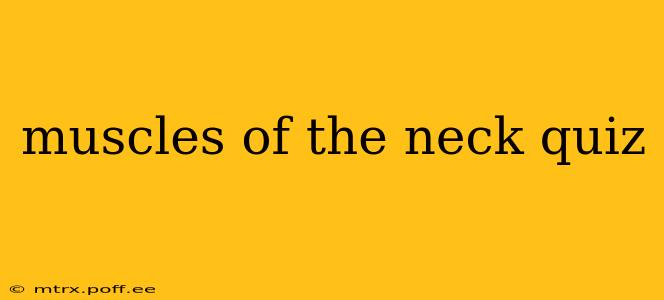Test Your Knowledge: Muscles of the Neck Quiz
The neck, a seemingly simple structure, is actually a complex interplay of muscles responsible for crucial functions like head movement, swallowing, and breathing. This quiz will test your knowledge of the major muscles of the neck. Let's see how well you know your anatomy!
Instructions: Choose the best answer for each multiple-choice question. At the end, you'll find the answers and a brief explanation of each muscle group.
Question 1: Which muscle is primarily responsible for flexing the head?
a) Sternocleidomastoid b) Trapezius c) Splenius Capitis d) Semispinalis Capitis
Question 2: What muscle group, located deep within the neck, plays a significant role in swallowing and speech?
a) Suprahyoid muscles b) Infrahyoid muscles c) Scalene muscles d) Both a and b
Question 3: Lateral flexion of the neck (tilting the head to the side) is primarily achieved by which muscle?
a) Trapezius b) Sternocleidomastoid c) Longus Colli d) Rectus Capitis Anterior
Question 4: Which of these muscles is NOT directly involved in head rotation?
a) Sternocleidomastoid b) Splenius Capitis c) Omohyoid d) Levator Scapulae (partially)
Question 5: The scalene muscles are located in which region of the neck?
a) Anterior b) Lateral c) Posterior d) Deep within the throat
Answer Key and Explanations:
-
a) Sternocleidomastoid: This prominent muscle, running diagonally across the neck, is the primary flexor of the head. It also contributes to head rotation and lateral flexion.
-
d) Both a and b: Both suprahyoid (above the hyoid bone) and infrahyoid (below the hyoid bone) muscle groups are essential for swallowing and speech. The suprahyoid muscles elevate the hyoid bone and larynx during swallowing, while the infrahyoid muscles depress them.
-
b) Sternocleidomastoid: While other muscles contribute, the sternocleidomastoid is the major muscle responsible for lateral flexion of the neck.
-
c) Omohyoid: The omohyoid muscle is primarily involved in depressing the hyoid bone, rather than directly contributing to head rotation. While the levator scapulae does assist in some head movements, its primary function is scapular elevation.
-
b) Lateral: The scalene muscles (anterior, middle, and posterior) are located laterally in the neck, between the cervical vertebrae and the first two ribs. They are involved in respiration and neck flexion.
Frequently Asked Questions (FAQs) about Neck Muscles:
What are the main functions of the neck muscles?
The neck muscles have several crucial functions, including head movement (flexion, extension, rotation, lateral flexion), swallowing, speech, and respiration. They provide stability and support to the head and neck.
How many muscles are in the neck?
The exact number of muscles in the neck is debated, as some sources classify groups differently, or include muscles with overlapping functions in the surrounding areas (like shoulder and back muscles). However, there are numerous individual muscles, totaling dozens, working together in complex ways.
What causes neck muscle pain?
Neck pain can result from various factors, including poor posture, muscle strain, injury, inflammation (like arthritis), and nerve compression. Stress can also contribute to muscle tension.
What are some ways to strengthen neck muscles?
Gentle neck exercises, stretching, yoga, and proper posture are all excellent ways to strengthen and support the neck muscles. Always consult a physician or physical therapist before starting any new exercise program.
Can I self-diagnose neck muscle problems?
No. If you are experiencing neck pain or discomfort, it is crucial to consult a healthcare professional for a proper diagnosis and treatment plan. Self-diagnosing can lead to improper treatment and potential complications.
This quiz and FAQ section should provide a good foundation of knowledge on the muscles of the neck. Remember that anatomy is complex, and this is a simplified overview. For a deeper understanding, consult anatomical textbooks and reputable online resources.
